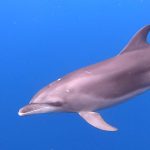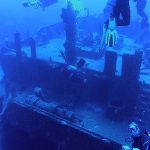On the island of Roatán, this summer, I finished a research project that I’d started five years ago. Having some well-earned down-time, I visited Coconut Tree Divers in the town of West End to earn my PADI Open Water Scuba Diver certification. Having snorkeled in Roatán, I found the colorful aquatic life found in the coral reef to be quite enchanting and only yards from the beach; however my excessive buoyancy prevented me from exploring more than several feet below the surface. I thought that Scuba Diving would enable, at the very least, descending more than a few feet beneath the surface.
I was surprised by how comfortable I felt under water. I’d always been rather anxious snorkeling because, mostly due to ill-fitting rental gear and poor technique—both of which contributed to swallowing a lot of sea water. With scuba diving, I still had floppy rental gear, but having your air always available, drinking sea water was no longer a problem, and that anxiety disappeared.
The instruction for this course covers the basic techniques to stay alive while underwater, practiced to the point that we could take care of ourselves within limits that minimize risk. Being next to the beach and boat dock, and having many deep diving sites less than 10 minutes away, certification took only a couple of days leaving time for “fun dives.”
After the certification, however, there is still more to learn and much more to practice. The next week I went back for the PADI Advanced Open Water certification. With the Open Water Scuba Diver certificate, you can dive without an instructor to a depth of 60’ (18m). In Roatán, staying above 60’ deep will barely cramp your enjoyment as you can see most of the coral and many reef animals in this area. Also, as you descend, the color spectrum becomes only shades of blue and green, your air consumption increases, and the time you can spend underwater due to Nitrogen absorption decreases. Bottom line: there is much to see in the 30-60’ depths around Roatán, so the Open Water Scuba Diver certificate is the ticket to a lot of interesting sites and sights!
The Advanced Open Water certificate does open up greater depths (up to 120’); however, it also includes additional skills—buoyancy and navigation, for example. After my advanced certification, I felt much more comfortable finding my way around underwater. While I wasn’t particularly stressed out under water after my initial certification, after my Advanced course, I could now relax. I’ve described it as doing yoga with fish and sea turtles.
At neutral buoyancy, you’re weightless, for all practical purposes. At neutral buoyancy you can ascend and descend simply through breathing. As an added bonus, the more you relax, the less air you use, letting you stay underwater longer. Watching the pro divers (dive masters and instructors) on our dives, you could see how they moved as little as possible while still getting to where they wanted to be. Us newbies, however, were another story.
I’m now hooked on it and strongly recommend Coconut Tree Divers in West End, Roatán, if you’re looking for your ticket to another world!


